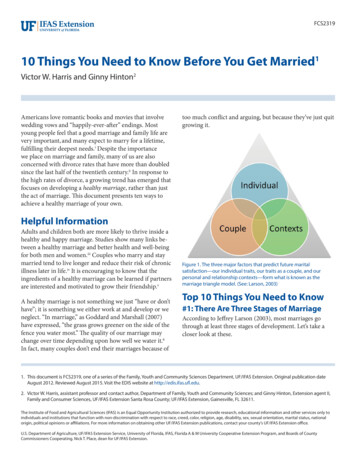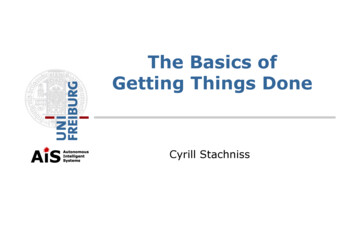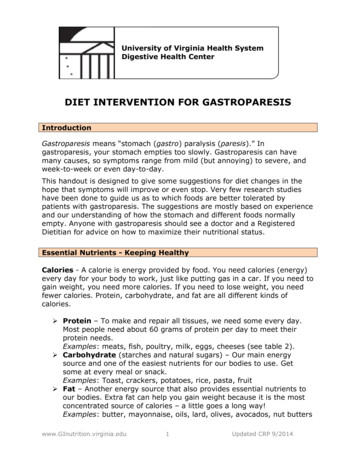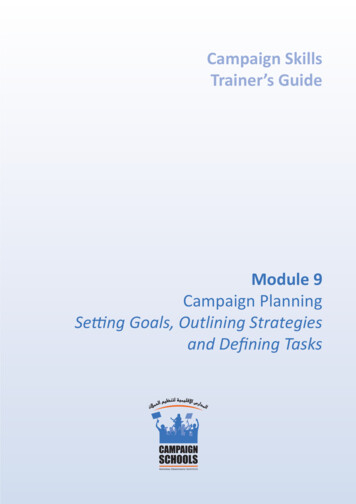
Transcription
FCS231910 Things You Need to Know Before You Get Married1Victor W. Harris and Ginny Hinton2Americans love romantic books and movies that involvewedding vows and “happily-ever-after” endings. Mostyoung people feel that a good marriage and family life arevery important, and many expect to marry for a lifetime,fulfilling their deepest needs.i Despite the importancewe place on marriage and family, many of us are alsoconcerned with divorce rates that have more than doubledsince the last half of the twentieth century.ii In response tothe high rates of divorce, a growing trend has emerged thatfocuses on developing a healthy marriage, rather than justthe act of marriage. This document presents ten ways toachieve a healthy marriage of your own.too much conflict and arguing, but because they’ve just quitgrowing it.Helpful InformationAdults and children both are more likely to thrive inside ahealthy and happy marriage. Studies show many links between a healthy marriage and better health and well-beingfor both men and women.iii Couples who marry and staymarried tend to live longer and reduce their risk of chronicillness later in life.iv It is encouraging to know that theingredients of a healthy marriage can be learned if partnersare interested and motivated to grow their friendship.vA healthy marriage is not something we just “have or don’thave”; it is something we either work at and develop or weneglect. “In marriage,” as Goddard and Marshall (2007)have expressed, “the grass grows greener on the side of thefence you water most.” The quality of our marriage maychange over time depending upon how well we water it.6In fact, many couples don’t end their marriages because ofFigure 1. The three major factors that predict future maritalsatisfaction—our individual traits, our traits as a couple, and ourpersonal and relationship contexts—form what is known as themarriage triangle model. (See: Larson, 2003)Top 10 Things You Need to Know#1: There Are Three Stages of MarriageAccording to Jeffrey Larson (2003), most marriages gothrough at least three stages of development. Let’s take acloser look at these.1. This document is FCS2319, one of a series of the Family, Youth and Community Sciences Department, UF/IFAS Extension. Original publication dateAugust 2012. Reviewed August 2015. Visit the EDIS website at http://edis.ifas.ufl.edu.2. Victor W. Harris, assistant professor and contact author, Department of Family, Youth and Community Sciences; and Ginny Hinton, Extension agent II,Family and Consumer Sciences, UF/IFAS Extension Santa Rosa County; UF/IFAS Extension, Gainesville, FL 32611.The Institute of Food and Agricultural Sciences (IFAS) is an Equal Opportunity Institution authorized to provide research, educational information and other services only toindividuals and institutions that function with non-discrimination with respect to race, creed, color, religion, age, disability, sex, sexual orientation, marital status, nationalorigin, political opinions or affiliations. For more information on obtaining other UF/IFAS Extension publications, contact your county’s UF/IFAS Extension office.U.S. Department of Agriculture, UF/IFAS Extension Service, University of Florida, IFAS, Florida A & M University Cooperative Extension Program, and Boards of CountyCommissioners Cooperating. Nick T. Place, dean for UF/IFAS Extension.
Romantic Love – Passion and physical attraction are mostimportant during this phase. Issues like sacrifice, selfishness, expectations, and crisis are not typically faced veryoften at this stage.Disillusionment and Distraction – During this stage, dailylife stressors occur and expectations have to be changed.Couples often feel disappointed and unfulfilled by the endof this stage.Dissolution, Adjustment with Resignation, or Adjustment with Contentment – A couple has at least threeoptions during this stage: They can separate or end the marriage. They can adjust to the new reality, expecting that theirmarriage will not improve and they will continue to growapart. They can work hard on the relationship, gain new tools,work through issues, and develop a greater but differentlove, with a little romantic love added back into the mix.#2: Don’t Buy into Common MarriageMythsOne common marriage myth comes to us from folklore:“Never go to bed angry with your spouse.” It’s importantto understand, though, that sometimes when we’re tiredand stressed we may just need to sleep on it and settle theissue the next morning. A tired mind may cause us to saysomething we later regret. Larson (2003) shares some othercommon myths: “If my partner and I have a disagreement, our relationship is doomed!” The truth is that conflict that is handledconstructively can be a healthy way to improve ourmarriage. “If my spouse loves me, s/he should know what I wantand need to be happy.” The truth is that it is our responsibility to communicate our expectations so our spouseknows what we need to be happy. “I can change my spouse by pointing out his/her weaknesses, errors, and other flaws.” The truth is that criticizing our partner and focusing on weaknesses, errors, andflaws rather than strengths and positive traits will onlypromote negativity and damage our marital friendship. “Marriage should always be a 50-50 partnership.” Thetruth is that there are many times throughout a marriagethat one partner or the other gives more than 50 percent.In fact, some couples may be happy and stable with 60-40and 70-30 partnerships.10 Things You Need to Know Before You Get MarriedIf you’re feeling stressed because something in your marriage isn’t going the way it’s “supposed” to go, check to makesure you’re not holding on to a marriage myth.#3: Marital Satisfaction Can Be Predictedby Three Important FactorsThere are three general factors that can help predict howhappy and stable your marriage will be (Larson and Holman, 1994). These factors are (from least predictive to mostpredictive): background and contexts, individual traits andbehaviors, and couple traits and interactions. Put together,these three factors form what Larson (2003) calls theMarriage Triangle. Each group of factors has an impact onthe others.#4: Contexts Are the Settings in WhichPeople Develop Individual or CoupleCharacteristicsContexts are included in the Marriage Triangle becausethey are the foundation for building individual and coupletraits. There are personal contexts, which include everything we bring into the marriage (e.g., the quality of ourparents’ marriage, or how we fit into our original family),and relationship contexts, which include qualities fromthe marriage itself (e.g., support from in-laws, unresolvedmarital problems, financial issues, etc.).#5: Individual Traits Include Your OwnPersonality, Attitudes, and SkillsTaking care of ourselves socially, emotionally, mentally,spiritually, and physically can contribute to our overallmarital satisfaction. For example, some individual traitssuch as having difficulty coping with stress, believingmarriage myths, impulsive behavior, untreated depression,extreme self-consciousness or excessive anger and hostilitycan stand in the way of our marital happiness and stability.Alternatively, individual traits such as being social, flexible,and assertive as well as having high levels of self-esteem,commitment, and an ability to love are some of the important factors that can help us find and experience maritalhappiness and stability.#6: Couple Traits Include Communicationand Conflict-resolution SkillsSome positive couple traits, according to Larson (2003), areas follows: Cohesion—Time spent together often leads to a feeling ofemotional closeness.2
Intimacy—This includes a combination of affection,sexual relations, cohesion and being open and vulnerablewith each other. Control or Power Sharing—If one person has too muchpower or control in decision-making, there may be afeeling of dissatisfaction. When there is equitable giveand-take, both spouses tend to be more satisfied. Consensus—How we are able to agree with our partneron issues is what is important here. We can reach consensus by being alike, by accepting differences or by healthyconflict resolution.#7: Change Yourself FirstAccording to Douglas Abbot (2003), there are at least threereally important principles that can lead us toward greatermarital happiness and stability: (1) Change our behavior;(2) Change our attitude; and (3) Change our heart. We canget “stuck” in our relationships if we believe the false ideathat our relationships can only get better if our partner willchange. There is so much we can do to gain new knowledge,new attitudes, and new skills that will help us change ourrelationships in positive ways.#8: Practice the 80–20 RuleDr. Abbot (2003) developed the 80–20 rule after he read astory called “80 percent I love you, 20 percent I hate you.”The point is to overlook the few small things (20 percent)that we may dislike about our partner and to focus on themany things (80 percent) that we like.#9: Change Our HeartThis goes along with the 80–20 rule. It’s important to allowour hearts to change along with our behavior. Even thoughwe can’t force our hearts to change, we can make ourselvesavailable for a change of heart by doing the right things forthe right reasons in our relationships. If we need to say weare sorry, for example, doing the right thing by asking forforgiveness is part of changing our heart.#10: Seek Marital TherapyMost relationships get “stuck” at some point along theway and need some help to get “unstuck.” Seeking maritaltherapy doesn’t mean we’re weak or foolish. Wise couplesseek marital therapy early, before their marriage has achance to fall apart (see www.therapistlocator.com).Things You Can UseMost marriages fall somewhere along a continuum fromunhealthy to healthy. They grow and change with time and10 Things You Need to Know Before You Get Marriedeffort. When we are willing to gain new knowledge andrelationship skills, our “marriages,” according to one author,“can do more than merely survive: They can also thrive.”viiUse the selected guidelines presented in Table 1 to build ahealthy marriage, right from the start.Tracking how we are doing at regularly using theseguidelines is an important way to measure our potentialmarital happiness. Don’t get discouraged if you find out youare not using these guidelines as regularly as you would liketo. It’s normal. At the end of each day, take a minute andput a “ ” or a “-” next to each guideline as you track howwell you did with one or more of them throughout the day.Put this sheet up on the refrigerator door to remind you ofhow you are doing. When you become proficient at usingthese guidelines consistently, you can then better help yourpartner to use them regularly. Good luck, and remember toenjoy the journey!ReferencesAbbott, D. A. (2003). Change yourself and change yourmarriage. Marriage and Families, 1, 2–8.Goddard, W., & Marshall, J. (2007). The Marriage Garden.San Francisco, CA: Jossey-Bass.Harris, V. W. Preparation for marriage: 10 things you’ll wishyou knew. Strongermarriage.org. rriage/Larson, J. H. (2003). The great marriage tune-up book. SanFrancisco, CA: Jossey-Bass.Larson, J. H. & Holman, T. B. (1994). Premarital predictors of marital quality and stability. Family Relations, 43,228–237.EndnotesWhitehead, B. D., & Popenoe, D. (2000). Sex withoutstrings, relationships without rings. The State of ourUnions, 2000 (pp. 6-20). Piscataway, NJ: The NationalMarriage Project, Rutgers University Press. http://www.stateofourunions.org/pdfs/SOOU2000.pdf [5 September2012].iKarney, B. R., Beckett, M. K., Collins, R. L., & Shaw, R.(2007). Adolescent romantic relationships as precursorsto healthy adult marriage – executive summary. SantaMonica, CA: Rand Corporation and The Department ofHealth and Human Services. arr precursors/reports/ii3
adolescent relationships/adolescent relationships 0707.pdf [5 September 2012].Howell, P., (2008). Healthy marriages, healthy lives.California Healthy Marriages Coalition. http://camarriage.com/research/index.ashx?nv 8&pg 30iiiStanton, J. J., (2008). What is the relationship of marriageto physical health? National Healthy Marriage ResourceCenter. http://healthymarriageinfo.orgivMoore, K. A., Jekielek, S. M., Bronte-Tinkew, J., Guzman,L., Ryan, S. & Redd, Z. (2004). What is “healthy marriage”?Defining the Concept. Child Trends Research Brief. http://www.childtrends.org/Files//Child Trends-2004 9 1 RBWhatIsHealthyMarr.pdfvMoore, Jekielek, Bronte-Tinkew, Guzman, Ryan & Redd,Op. cit.viviiHowell, Op. cit.10 Things You Need to Know Before You Get Married4
Table 1. Guidlines for building a healthy marriageTarget Behavior:Monday1. Marriage Myths 2. Positive Communication(Cohesion; Intimacy) 3. Constructive ConflictResolution (Power aturdaySundayTotals4. Change Yourself First5. The 80–20 Rule6. Change Your Heart10 Things You Need to Know Before You Get Married5
10 Things You Need to Know Before You Get Married 3 Intimacy—This includes a combination of affection, sexual relations, cohesion and being open and vulnerable with each other. Control or Power Sharing—If one person has too much power or control in decision-making, there may be a feeling of dissat










